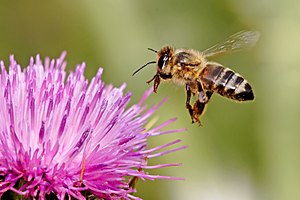Template:Species-2011-10-2
Species of the month
editWestern Honey Bee
editSome facts on this bee:
Hive temperature: 32 ± 0.6°C .
Hive population: Between 40,000 and 80,000.
Life span: Three to four years.
Diet: Flower nectar.
Range: Native to the continents of Europe, Asia, and Africa. Introduced to other parts of the world.
First described: By the Swedish "Father of Taxonomy" Linnaeus in 1758.
Apis mellifera stings, but with a sweet touch. It is the most commonly domesticated species of honey bee. Bees are able to direct their sisters to food sources through special "waggle dances". When flying, their wings buzz at 200 beats per second, and can carry them for up to 10 km at speeds of up to 24 km per hour. The average worker bee visits 50 to 100 flowers during a collection trip, and produces about 1/12th teaspoon of honey in her lifetime. The queen can live up to 5 years and is capable of laying up to 2500 eggs each day. The genus Apis (Honey bees) includes 7 species and is part of the family Apidae. Honey bees represent only a small fraction of the approximately 20,000 known species of bees.
(Archived from Template:Species of the week)
